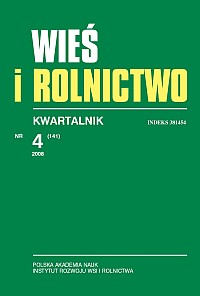Wspólna polityka rolna a polityka spójności w kontekście przeglądu budżetu UE
Common Agricultural Policy and Cohesion Policy in the Context of the EU Budget's Revision
Author(s): Łukasz HardtSubject(s): Economy
Published by: Instytut Rozwoju Wsi i Rolnictwa Polskiej Akademii Nauk
Keywords: development of rural areas; common agricultural policy; cohesion policy; revision of the EU budget; rozwój wsi; wspólna polityka rolna UE; polityka spójności UE; przegląd budżetu UE
Summary/Abstract: Activities connected with the development of rural areas are conducted both within the so-called Second pillar of the European Union’s Common Agricultural Policy (CAP) and within programmes financed from the cohesion policy fund. The question of selection of the method of implementation of the rural development policy becomes particularly important in the present situation of discussions on changes in CAP. These discussions are stimulated both by internal factors (revision of the EU budget and CAP’s health check) and external factors (WTO negotiations and changes on the global food market). All these factors have been thoroughly analysed in this article. The resulting conclusion is that the revision of the EU budget, which relates both to CAP and to the cohesion policy, may prove to be the most important catalyst of changes in the manner of implementation of the rural development policy. The article describes the key dilemmas connected with the selection of methods for the introduction of solutions linked to the policy of rural development. The author of the article claims that because of the low mobility of production factors in Poland it could prove advantageous to shift much of the burden of implementation of the rural development policy onto the cohesion policy. He also presents arguments to prove that an increase in the EU funds allocated to rural development via the cohesion policy, introduced at the expense of means flowing into the rural areas via the Second pillar of CAP may reduce the risk of a decrease in the transfer of EU funds to Poland’s rural areas after 2013. The author of the article also proposes an institutional mechanism for the implementation of rural development policy that would be less dependant on CAP’s Second pillar. Działania z zakresu rozwoju obszarów wiejskich (ROW) realizowane są zarówno w ramach tzw. II filaru wspólnej polityki rolnej UE (WPR), jak i programów finansowanych ze środków polityki spójności. Kwestia wyboru sposobu realizowania polityki ROW nabiera pierwszorzędnego znaczenia w sytuacji obecnej debaty nad zmianami WPR. Dyskusja ta stymulowana jest zarówno czynnikami wewnętrznymi (m.in. przeglądem budżetu UE oraz tzw. health check WPR), jak i zewnętrznymi (m.in. negocjacjami WTO oraz zmianami na światowym rynku żywnościowym). Czynniki te są szczegółowo omówione w niniejszym artykule, gdzie wskazuje się, że najważniejszym katalizatorem zmian w sposobie realizacji polityki ROW może okazać się przegląd budżetu UE, który dotyczy zarówno WPR, jak i polityki spójności. W artykule wskazano na najważniejsze dylematy związane z wyborem sposobu prowadzenia działań z zakresu ROW. W tekście twierdzi się, iż biorąc pod uwagę małą mobilność czynników produkcji w Polsce, korzystne może okazać się przeniesienie ciężaru realizacji polityki ROW w większym stopniu na politykę spójności. Ponadto dowodzi się, iż zwiększenie alokacji środków UE na rozwój wsi poprzez politykę spójności kosztem ilości środków kierowanych na wie
Journal: Wieś i Rolnictwo
- Issue Year: 141/2008
- Issue No: 4
- Page Range: 47-65
- Page Count: 19
- Language: Polish

